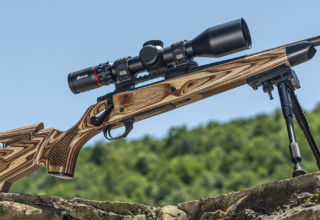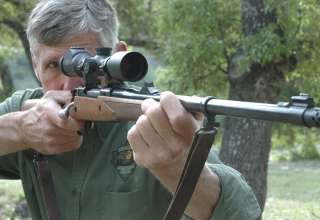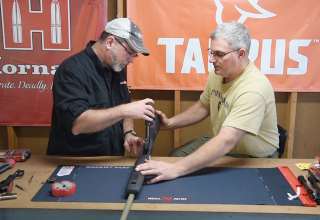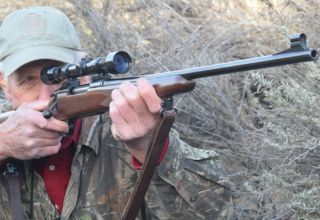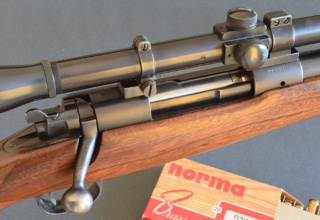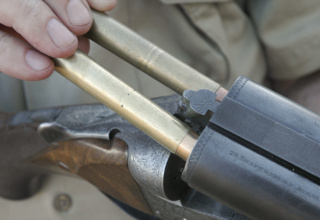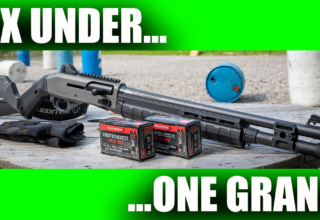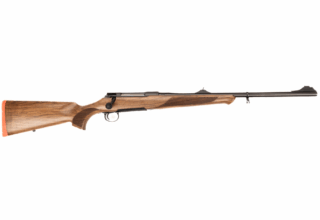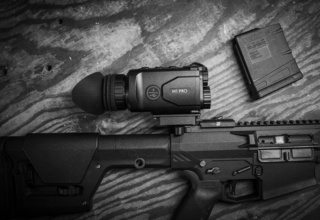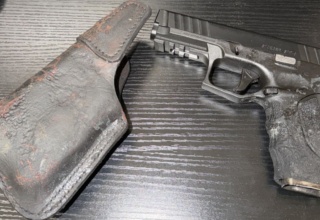You didn’t choose a .30-30. A rifle-stock for shooting far begs features absent on your saddle gun.
by Wayne van Zwoll
Any hunter whose boot-soles haven’t been babied in tree-stands will insist that a rifle be portable, reliable, and easy to aim and fire accurately. A soldier would concur, perhaps adding firepower to that list. Since the advent of smokeless powder, rifles have delivered on those demands, always with compromises. Adding power and accuracy to extend reach brings more trade-offs.
Some of them appear in the stock.
Slender grips and forends keep hunting rifles nimble and easy to carry. Sturdier handles suit battle rifles for service. There’s no call for heat shields on deer rifles or for butt-stocks to fit the smallest recruit in winter gear. Combat arms pass muster without the fit and finish that sell sporters.

Stocks for competitive prone and long-range events — even varminting when you depend on your bullets to do all the walking — take a different form than either hunting or service rifles. From sandbags on a bench or from your belly over a bipod, you need a stock with a flat, generous forend, also a steep grip so your trigger hand can relax vertically from a gently hooked thumb.
The comb must bring your eye comfortably to the sight or a scope’s optical axis. In a prone rifle, it must do both, for iron-sight and any-sight stages. Strap-on cheek pads sufficed on hunting rifles when combs were cut for irons. Late, higher combs helped us look through scopes. But as scopes got bigger and Picatinny rails appeared on rifles, stockers were driven to drink, trying to make one comb work for every shooter’s face with every sight setup.

Enter the adjustable comb. The simple, finger-operated clamp-style is inexpensive and can put your line of vision in just the right place. It also permits easy access to the bore for cleaning. If you’re buying or re-stocking a rifle for long-range shooting, insist on an adjustable comb!
Length of pull must suit your body. Truck-shouldered, bull-necked fellows with short arms won’t catch the trigger easily around a stock cut for a gangly stock-crawler. And even a stock that snuggles up like your first date will feel cold and distant if you change from light to bulky clothing or vice versa.
My Anschutz position rifle had a butt-plate run in and out by a wheel on a threaded rod, with guide rods top and bottom. Fetching but costly. Simple stacks of spacer plates work for less. Firing only from prone or across a bench, you’ll change length of pull seldom, if at all. But you must be able to tailor it.
Shooters who think it their mission — and snipers whose mission it actually is — to hit targets far away have beaten a path to McMillan Fiberglass Stocks, in Phoenix. Makers of top-end long-range rifles also tap McMillan’s selection of more than 30 stocks for myriad actions.

Back when a McMillan-barreled Remington was bringing me prone titles, a Benchrest competitor using a McMillan rifle in a McMillan stock fired a five-shot .009 inch group! Kelly McMillan has since focused the business on rifle-stocks. Seven years ago, after he and son Ryan sold McMillan Mfg., Kelly designed and began producing the MC3, an affordable, injection-molded solid-core stock for long- and short-action Remington 700s. Most other injection-molded stocks are polymer shells built to a price. But those hollow stocks expand and contract with changes in temperature; and even with reinforcing struts, a hollow forend is easily twisted. The MC3, of glass-filled polymer called Xenolite, is heavier (3 ¼ pounds, about the weight of walnut) but much more stable. Similar in form to the A5 favored by military units, the MC3 is available for long- and short-action Remington 700s.
The 15,000-square-foot McMillan Fiberglass Stocks factory has just added to its production slate the Z-1, an upscale 4-pound stock for stiff-barreled long-range rifles. Says Kelly, “It accepts M700 actions and clones like Defiance, Stiller, and Kelbly. The belly is contoured for M5 DBM bottom metal.”

Per the MC3, the Z-1 tapes 30 ¾ inches overall. Butt spacers add up to 1½ inches, bringing maximum LOP to 15. A clamp-bar-adjustable comb is standard. So, too, alloy pillars, flush swivel cups, an underside forend rail — all useful, if not essential, on a long-range rifle. Thumb shelves on either side of the steep, thick grip afford a relaxed hold for your trigger hand. An integral toe hook engages a rear pad or your other hand. Like the MC3, the Z-1 affords drop-in fit. I’ve installed it (also MC3s) on Remington 700s. Easy peasy. McMillan lists the Z-1 at $942, a tad more than it gets for the A5. You’ll find an MC3 for as little as $269.
However costly your action or scope, or accurate your barrel, hitting targets from afar can depend on the rifle’s stock. Well-chosen and adjusted, and carefully cradled, it puts a perfect shot in your hand.



